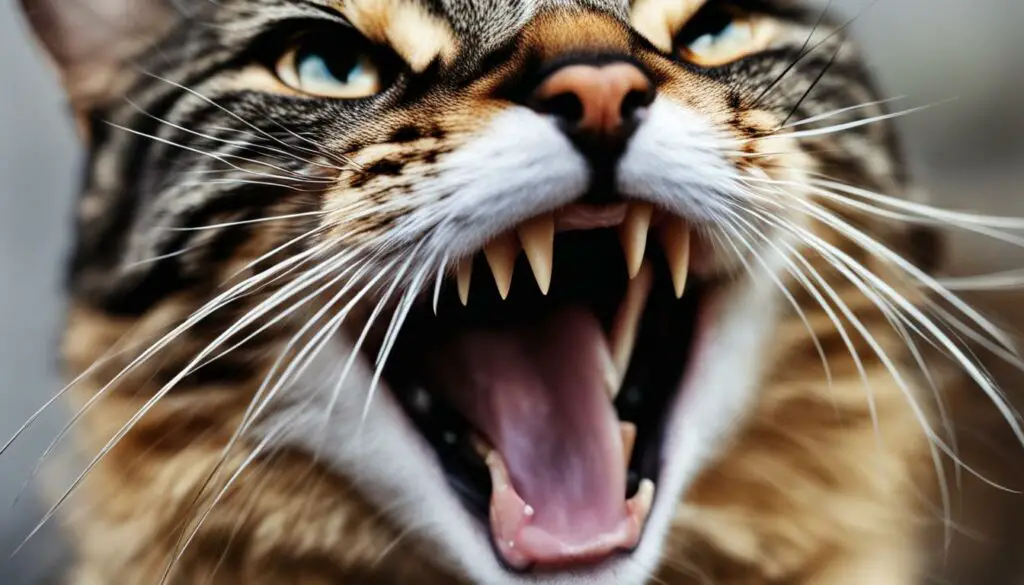As a cat owner, you may have wondered why your furry friend sometimes emits low rumbling noises. This behavior, known as cat grunting, is a form of feline communication that holds valuable insights into their emotions. Understanding why cats grunt can help enhance your bond with them and ensure their overall well-being.
Cat grunting differs from purring and serves as an expression of intense emotions, such as fear, discomfort, or pain. It is important to decode their vocalizations and decipher their body language to better understand their needs and ensure their comfort.
Key Takeaways:
- Cat grunting is a form of communication used by cats to express intense emotions.
- Understanding the difference between cat grunting and purring is essential.
- Cat grunting can indicate fear, discomfort, or pain.
- Decoding your cat’s body language can provide valuable insights into their emotions.
- Observing your cat’s behavior and consulting a veterinarian can help address underlying issues related to cat grunting.
Understanding Cat Grunting
When it comes to understanding our feline companions, it’s crucial to decode their unique vocalizations. One such vocalization that cats use to communicate their emotions is cat grunting. Cat grunting is a low, rumbling noise that resembles a growl, and it can indicate a range of emotions, including fear, discomfort, or pain.
Cat grunting is a natural behavior in cats, and it serves as a warning to other animals or humans to stay away. By identifying the different sounds your cat makes, you can gain a better understanding of their needs and emotions. Flattened ears, dilated pupils, and standing fur are often accompanying body language cues that indicate your cat is feeling threatened or scared.
Understanding cat grunting can help you create a safe and comfortable environment for your feline friend. By recognizing the signs and context of their grunting, you can respond appropriately to their needs. However, if the grunting is frequent or accompanied by other concerning symptoms, it is best to consult a veterinarian for further guidance and support.
By paying attention to your cat’s vocalizations and body language, you can strengthen your bond and provide the necessary care and attention that your cat needs. Remember that each cat is unique, and understanding their individual communication style is essential for their overall well-being.

Table: Cat Vocalizations and Their Meanings
| Vocalization | Meaning |
|---|---|
| Purring | Contentment |
| Meowing | Communication |
| Hissing | Fear or aggression |
| Yowling | Distress or mating calls |
| Growling | Warning or defense |
How to Identify Cat Grunting
Recognizing cat grunting is relatively simple. When cats grunt, they produce a low rumbling noise that is different from purring. Hearing this distinct sound can help you identify when your cat is feeling intense emotions such as fear, discomfort, or pain.
However, it’s not just the sound that can provide clues. Paying attention to your cat’s body language is equally important. Keep an eye out for signs like flattened ears, dilated pupils, and standing fur. These physical indicators can indicate that your cat is feeling threatened or scared when they’re grunting.
Understanding your cat’s grunting behavior and body language is crucial for recognizing when they may be experiencing discomfort or pain. By being attentive and observant, you can provide the necessary care and attention to ensure your furry friend’s well-being.
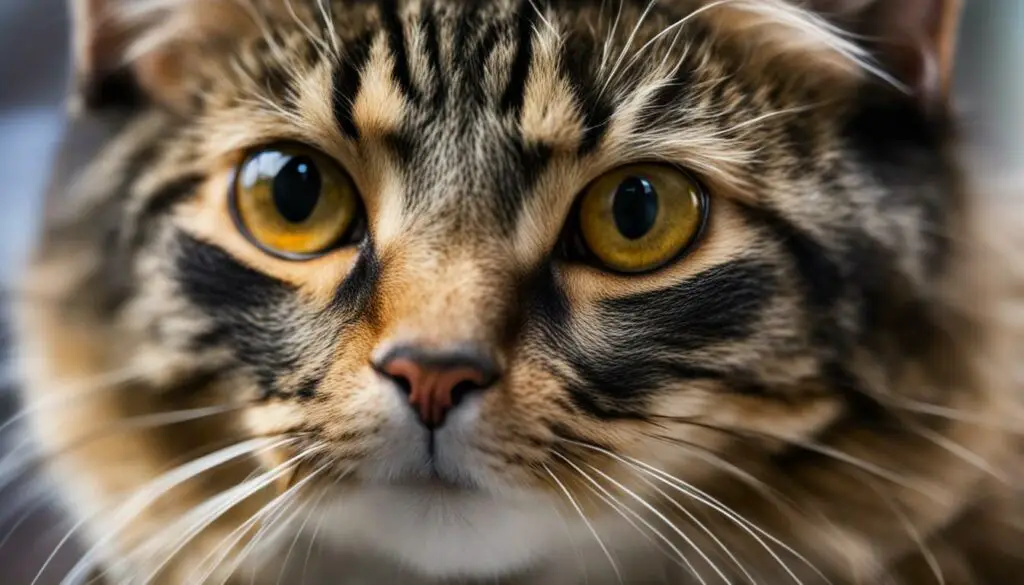
Table: Cat Grunting Signs and Body Language
| Signs | Meaning |
|---|---|
| Low rumbling noise | Expression of intense emotions like fear, discomfort, or pain |
| Flattened ears | Feeling threatened or scared |
| Dilated pupils | Sign of being on high alert or feeling threatened |
| Standing fur | Indication of fear or aggression |
Reasons for Cat Grunting
Cat grunting can have several underlying reasons, including pain, discomfort, aggression, fear, or excitement. Understanding the cause behind your cat’s grunting can help you address their needs and provide appropriate care. Here are some common reasons why cats grunt:
Pain and Discomfort
Sometimes, cats may grunt when they are experiencing pain or discomfort. This can be due to various reasons, such as an injury, illness, or underlying health condition. If your cat’s grunting is accompanied by signs of distress, such as limping, excessive grooming, or loss of appetite, it is essential to consult a veterinarian for a proper diagnosis and treatment.
Aggression and Fear
Cats may also grunt as a warning sign when they feel threatened or aggressive. This behavior is particularly common if your cat is confronted by another animal or if they perceive a potential threat to their territory. It is important to give your cat space and avoid direct contact during these instances to prevent any potential harm or escalation of aggression.
Excitement
In some cases, cats may grunt out of excitement or anticipation. This can happen when they are about to play or receive a treat. While grunting in these situations is generally harmless, it is important to ensure that your cat’s excitement does not escalate into aggressive behavior. Providing appropriate outlets for their energy, such as toys or interactive play sessions, can help channel their excitement in a positive way.
Understanding the reasons behind your cat’s grunting can help you respond appropriately and address their needs. It is crucial to pay attention to their body language and observe any accompanying signs of distress or discomfort. If you are unsure about the cause of your cat’s grunting or if it is accompanied by concerning symptoms, consulting a veterinarian can provide further guidance and ensure your cat’s well-being.
| Reasons | Description |
|---|---|
| Pain and Discomfort | Cats may grunt when they are experiencing pain or discomfort due to injury or illness. |
| Aggression and Fear | Grunting can serve as a warning sign when cats feel threatened or aggressive. |
| Excitement | Cats may grunt out of excitement or anticipation for playtime or treats. |
Common Causes of Cat Grunting
Cat grunting is a form of communication that cats use to express a range of emotions, including stress, discomfort, pain, and anxiety. Understanding the common causes of cat grunting can help you address the underlying issues and provide the necessary care and attention for your feline friend.
Noise and Discomfort
Cats may grunt when they are exposed to loud noises or uncomfortable environments. It is their way of expressing their discomfort and seeking relief. Creating a calm and quiet space for your cat, away from loud noises or stressful situations, can help reduce their grunting and promote a sense of security.
Socialization and Stress
Cats are social creatures, and their grunting can be a way of communicating their stress or anxiety in social situations. Introducing your cat to new people, animals, or environments gradually can help reduce their stress levels and minimize grunting. Providing them with plenty of hiding spots, toys, and scratching posts can also help them feel more secure and less likely to grunt.
Pain and Discomfort
If your cat is grunting frequently, it could be a sign of underlying pain or discomfort. It is essential to observe their behavior and look for other signs of discomfort, such as limping, loss of appetite, or changes in litter box habits. If you suspect that your cat is in pain, it is crucial to consult a veterinarian for a proper diagnosis and treatment.
| Cause | Signs and Symptoms |
|---|---|
| Noise and Discomfort |
|
| Socialization and Stress |
|
| Pain and Discomfort |
|
By understanding the common causes of cat grunting and addressing them appropriately, you can help ensure your cat’s well-being and strengthen your bond with them. It is important to provide a safe and comfortable environment, socialize them gradually, and seek veterinary care when necessary. Remember, every cat is unique, and their grunting behavior may vary, so it is essential to observe their individual needs and preferences.
Cat Breeds Prone to Grunting
When it comes to cat grunting, certain breeds are more prone to this behavior than others. Understanding which cat breeds are more likely to grunt can help you better care for and communicate with your feline companion. Here are some cat breeds that are known to be more prone to grunting:
| Cat Breed | Predisposition to Grunting |
|---|---|
| Brachycephalic Cats | Due to their unique facial structure, brachycephalic breeds like Persians and Himalayans may be more prone to grunting. Their shorter noses and flattened faces can impact their respiratory system, leading to increased grunting. |
| Large Cats | Large cat breeds, such as Maine Coons and Ragdolls, may grunt more frequently due to their size. The bigger body mass and increased respiratory requirements can contribute to more noticeable grunting. |
| Overweight Cats | Cats that are overweight or obese may also be more prone to grunting. The excess weight can cause strain on their breathing and cardiovascular systems, leading to more frequent grunting episodes. |
It’s important to note that while these breeds may have a higher predisposition to grunting, not all cats within these breeds will exhibit this behavior. Each cat is unique, and individual temperament and health also play a role in vocalization patterns.
If you have a cat from one of these breeds and notice them grunting more frequently or showing signs of discomfort or distress, it’s essential to monitor their health closely. Regular veterinary check-ups, maintaining a healthy weight, and providing appropriate care and attention can help ensure the well-being of these cat breeds prone to grunting.
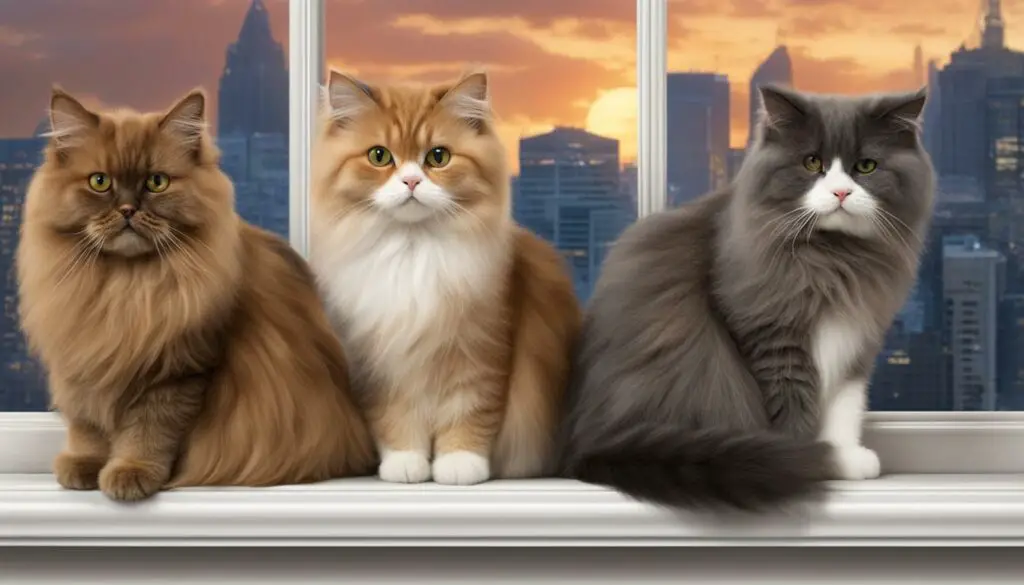
Familiarizing Yourself with Brachycephalic Cats
Brachycephalic cats, such as Persians and Himalayans, are worth mentioning when discussing cat breeds prone to grunting. Their unique facial structure, characterized by shortened noses and flattened faces, can contribute to respiratory issues and a higher likelihood of grunting.
It’s crucial to be aware of the specific needs and potential health challenges of brachycephalic cats. These breeds may require extra care and attention to ensure their comfort and well-being. Regular monitoring, keeping a close eye on their breathing patterns, and consulting with a veterinarian can help you provide the best possible care for your brachycephalic cat.
How to Respond to Your Cat’s Grunting
When your cat grunts, it’s essential to pay attention to their behavior and context. Observing their body language can give you valuable insights into their emotions and needs. If the grunting is occasional and doesn’t seem to bother your cat, you may not need to take immediate action. However, if the grunting is frequent or accompanied by other symptoms, it’s best to consult a veterinarian.
Providing comfort and reducing stress can help alleviate your cat’s discomfort. Creating a calm and comfortable environment for your cat is important, with cozy beds or hiding spots where they can retreat to when they feel overwhelmed. Interactive toys and playtime can also provide mental stimulation and help reduce stress.
If you’re unsure about how to respond to your cat’s grunting, consulting a veterinarian is always a good idea. They can evaluate your cat’s overall health and determine if there are any underlying medical issues causing the grunting. They may also provide advice specific to your cat’s needs and recommend any necessary treatments or interventions.
Understanding Cat Vocalizations
When it comes to understanding our feline friends, vocalizations play a crucial role. Cats have a wide range of vocalizations, each with its own unique meaning and purpose. From the soothing purr to the demanding meow, and the fierce hiss to the mournful yowl, their vocal repertoire is vast and diverse.
Cat Vocalizations
| Vocalization | Meaning |
|---|---|
| Purr | Contentment, relaxation |
| Meow | Attention-seeking, hunger, communication |
| Hiss | Fear, aggression |
| Yowl | Distress, mating calls |
| Snarl | Threat, warning |
“A cat’s vocalizations are their way of communication.”
Of course, understanding what your cat is trying to tell you through their vocalizations goes beyond simply knowing the meanings. It also involves paying attention to their body language, context, and the overall situation. For example, a meow accompanied by rubbing against your leg may mean your cat is seeking attention and affection. On the other hand, a hiss accompanied by an arched back and flattened ears is a clear sign that your cat feels threatened or aggressive.
“Paying attention to the context and body language can help decipher your cat’s message.”
While vocalizations are an important part of feline communication, it’s essential to consider other factors when interpreting your cat’s needs and emotions. Observing their overall behavior, body posture, and interactions with their environment and other animals can provide valuable insights into what they’re trying to express. Building a strong bond with your cat involves paying attention to the full range of their communication, both vocal and non-vocal, to ensure their well-being and happiness.
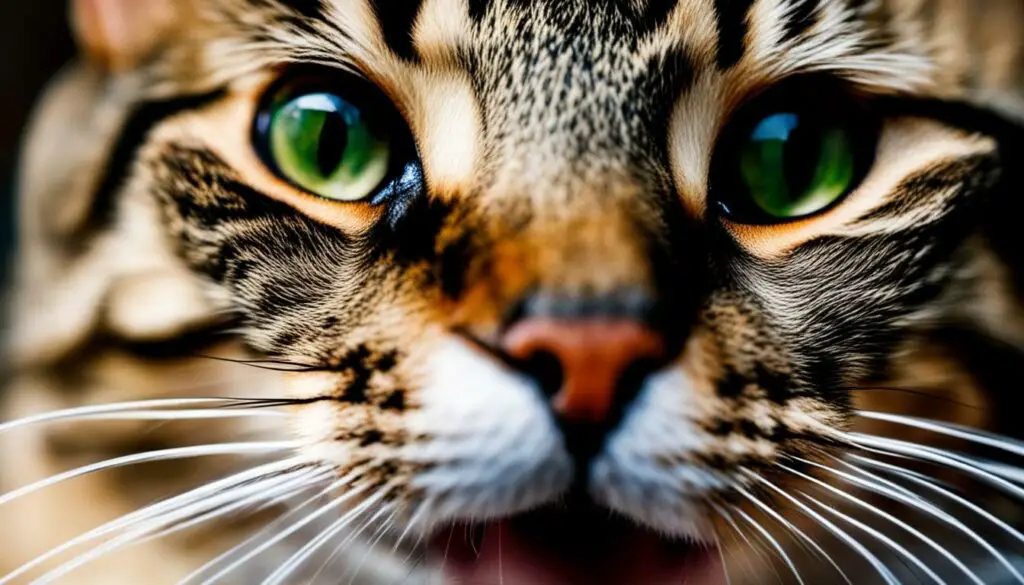
Common Cat Sounds and What They Mean
As cat owners, we often find ourselves fascinated by the various sounds our furry friends make. From the gentle purring to the loud meows, each sound has its own unique meaning. Understanding these cat sounds can help us better communicate with our feline companions and meet their needs. Let’s take a closer look at some common cat sounds and what they mean.
“I love the sound of my cat’s purring. It’s so soothing and comforting.” – Cat Owner
The Purr:
One of the most well-known cat sounds is the purr. Cats purr when they feel content and relaxed. It’s a sign that they are comfortable and enjoying their surroundings. Purring can also indicate that your cat is seeking attention or trying to calm themselves down in stressful situations. So, the next time you hear your cat purring, know that they are happy and content.
The Meow:
Meowing is a form of communication that cats use to get our attention. It can mean different things depending on the context. Your cat may meow to greet you, ask for food, or simply to get some playtime. Some cats are more vocal than others and may meow frequently to express their needs. Pay attention to the tone and intensity of the meow to better understand what your cat is trying to communicate.
The Hiss:
When a cat hisses, it usually means they are feeling fearful or threatened. It’s a warning sound that cats use to keep potential threats at bay. Hissing can also occur during conflicts with other cats or animals. If your cat hisses, it’s best to give them space and avoid any further interactions until they feel safe again.
The Yowl and Moan:
Yowling and moaning are more intense vocalizations that cats use to express distress or discomfort. This can happen when a cat is in pain, feeling anxious, or in need of attention. Yowling is often associated with mating behaviors, as male cats may yowl to attract females. If your cat is yowling or moaning excessively, it’s essential to consult a veterinarian to rule out any health issues.
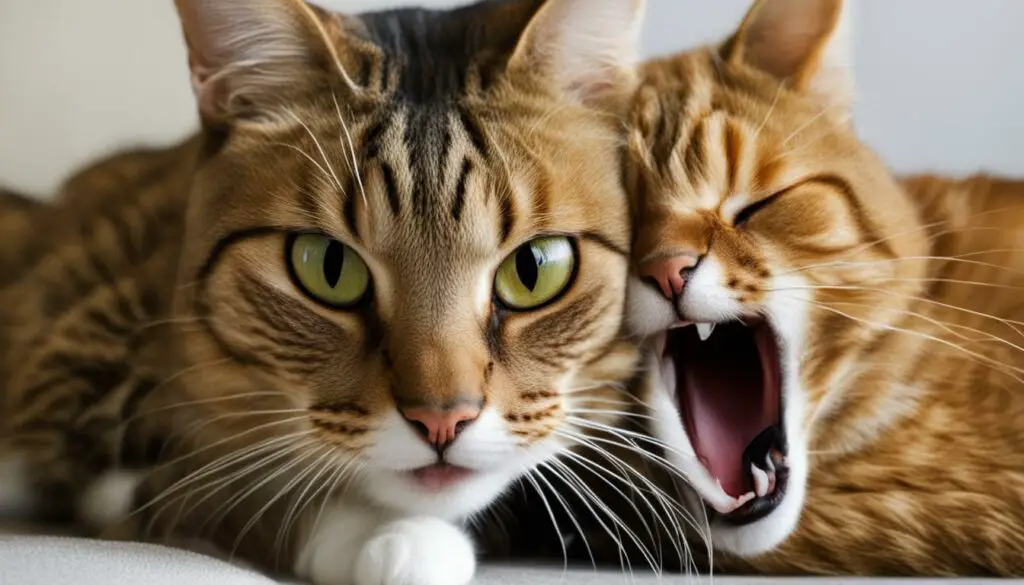
| Cat Sound | Meaning |
|---|---|
| Purr | Contentment, relaxation, seeking attention |
| Meow | Communication, greetings, seeking food or playtime |
| Hiss | Fear, threat, conflict |
| Yowl and Moan | Distress, discomfort, pain, mating behaviors |
When to Consult a Veterinarian
If you notice any sudden changes in your cat’s vocalizations or if the sounds are accompanied by other concerning symptoms, it is best to consult a veterinarian. As a responsible cat owner, it’s important to understand that cat sounds can sometimes indicate underlying health issues that require professional attention. Your veterinarian can perform a thorough examination and provide appropriate treatment or advice to address your cat’s needs.
Some signs that may indicate the need for a veterinary consultation include persistent or unusual vocalizations, such as excessive meowing or yowling that is out of the ordinary for your cat. If your cat’s grunting is accompanied by changes in appetite, weight loss, lethargy, or difficulty breathing, it is crucial to seek veterinary care promptly. These symptoms may be indicative of underlying health problems that require diagnosis and treatment.
Remember, cats are experts at hiding signs of pain or illness, and their vocalizations can offer important clues about their well-being. By consulting a veterinarian when you notice changes or concerns in your cat’s vocalizations, you can ensure early detection and intervention, ultimately promoting your cat’s overall health and comfort.
Table: Signs Your Cat May Need Veterinary Attention
| Signs | Possible Health Issues |
|---|---|
| Excessive or unusual vocalizations | Pain, discomfort, anxiety |
| Changes in appetite or weight loss | Dental problems, gastrointestinal issues, metabolic disorders |
| Lethargy or decreased activity | Infection, injury, systemic illness |
| Difficulty breathing | Respiratory infections, asthma, heart disease |
| Unusual behaviors or hiding | Stress, anxiety, underlying medical conditions |
Remember, it’s always better to be safe than sorry when it comes to your cat’s health. If you have any concerns or questions about your cat’s vocalizations or overall well-being, don’t hesitate to reach out to your veterinarian for professional guidance and support.
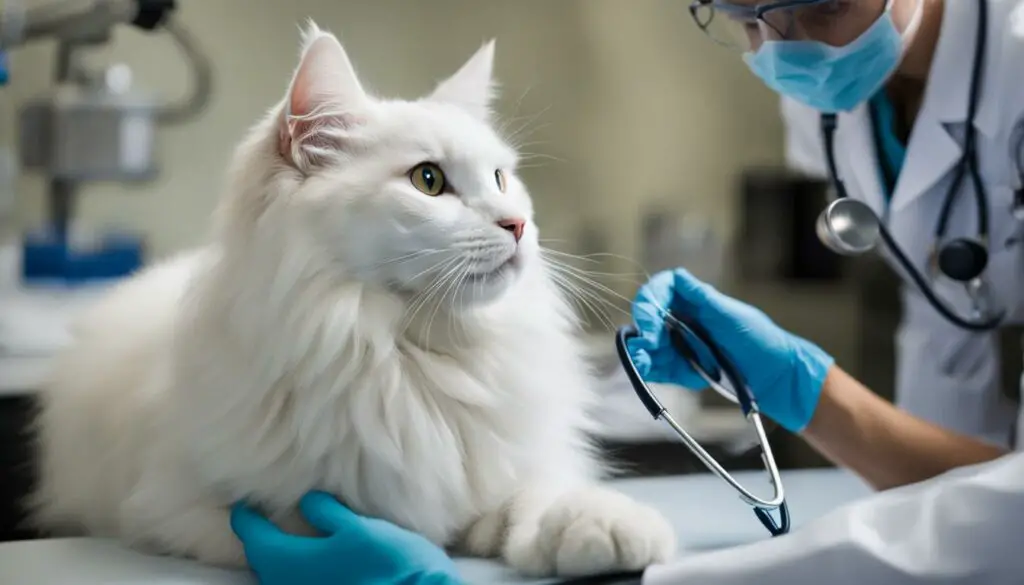
Tips for Comforting a Groaning Cat
If your cat is groaning, it’s important to provide comfort and reduce stress to help alleviate their discomfort. Here are some tips:
- Create a calm and comfortable environment: Ensure that your cat has a quiet space where they can retreat to when they feel overwhelmed or anxious. Provide cozy beds or hiding spots where they can relax and feel safe.
- Offer interactive toys and playtime: Engaging your cat in play can distract them from their discomfort and help them release pent-up energy. Use toys that allow them to engage their natural hunting instincts, such as feather wands or treat-dispensing puzzles.
- Use pheromone sprays or diffusers: Pheromones are natural chemical signals that cats use to communicate and feel secure. Using pheromone sprays or diffusers in your home can help reduce stress and anxiety for your cat.
- Provide gentle affection and reassurance: Spend time with your cat, offering gentle petting and soothing words. However, be mindful of your cat’s body language and cues. If they show signs of discomfort or agitation, give them space and respect their boundaries.
Remember, each cat is unique, so it’s important to observe and understand your cat’s individual preferences and needs. If your cat’s groaning persists or is accompanied by other concerning symptoms, it’s advisable to consult a veterinarian for further evaluation and guidance.
By providing comfort and reducing stress for your groaning cat, you can help promote their overall well-being and strengthen the bond between you and your feline friend.
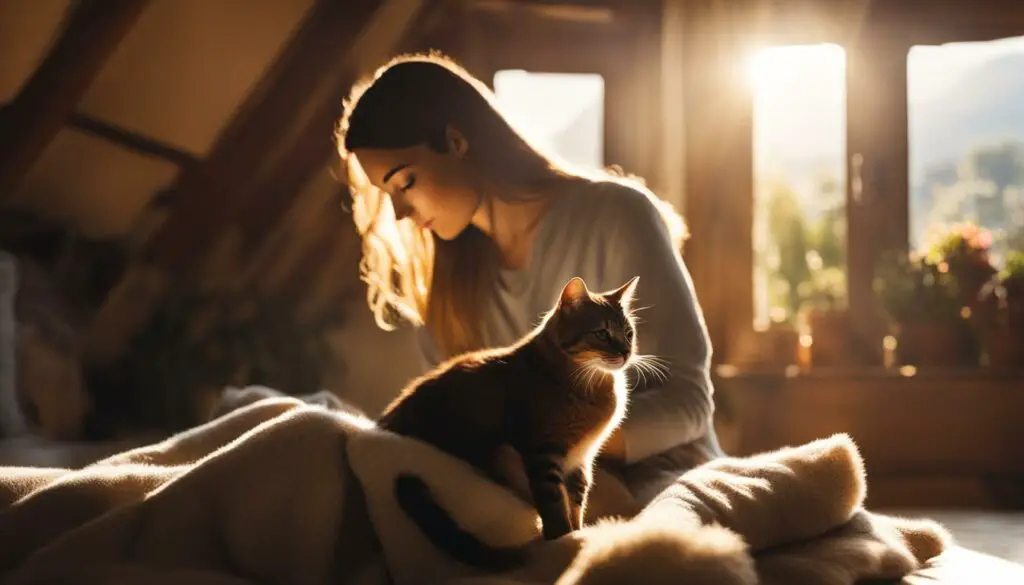
Expert Quote:
“Creating a calm and comfortable environment is key to comforting a groaning cat. Providing them with a safe space and engaging them in interactive play can help alleviate their stress and anxiety.” – Dr. Emily Thompson, Feline Behavior Specialist
Understanding Feline Language Beyond Groans
When it comes to understanding our feline companions, it is essential to go beyond their vocalizations and delve into the intricacies of their feline language. Cat communication goes beyond the grunts and meows; it encompasses a wide range of body language and behavior that can provide valuable insights into their emotions and needs.
One of the key aspects of feline language is their body language. By observing your cat’s tail, ears, and posture, you can gain a deeper understanding of their emotional state. For example, a raised tail may indicate excitement or confidence, while a tucked tail can signal fear or anxiety. Flattened ears could mean that your cat is feeling threatened or defensive. Paying attention to these subtle cues can help you interpret your cat’s intentions and respond accordingly.
“Understanding your cat’s body language is crucial in building a strong bond with them. By observing their behavior, you can better understand their needs and provide the appropriate care and attention.”
Another aspect of feline language is their behavior and interactions with their environment and other cats. For example, if your cat rubs against your legs, it is a sign of affection and marking territory. If they knead their paws, it indicates contentment or a desire for comfort. Additionally, watching how your cat interacts with other cats can give you insight into their social dynamics and hierarchy.
Table: Decoding Feline Body Language
| Body Language | Meaning |
|---|---|
| Raised tail | Excitement or confidence |
| Tucked tail | Fear or anxiety |
| Flattened ears | Feeling threatened or defensive |
| Rubbing against legs | Affection and territorial marking |
| Kneading paws | Contentment or desire for comfort |
Understanding feline language beyond grunts can help you strengthen your bond with your cat and provide the care they need. By paying attention to their body language and behavior, you can better interpret their emotions and respond appropriately. So the next time your cat communicates with you, take a moment to observe their non-verbal cues and engage in their unique language.
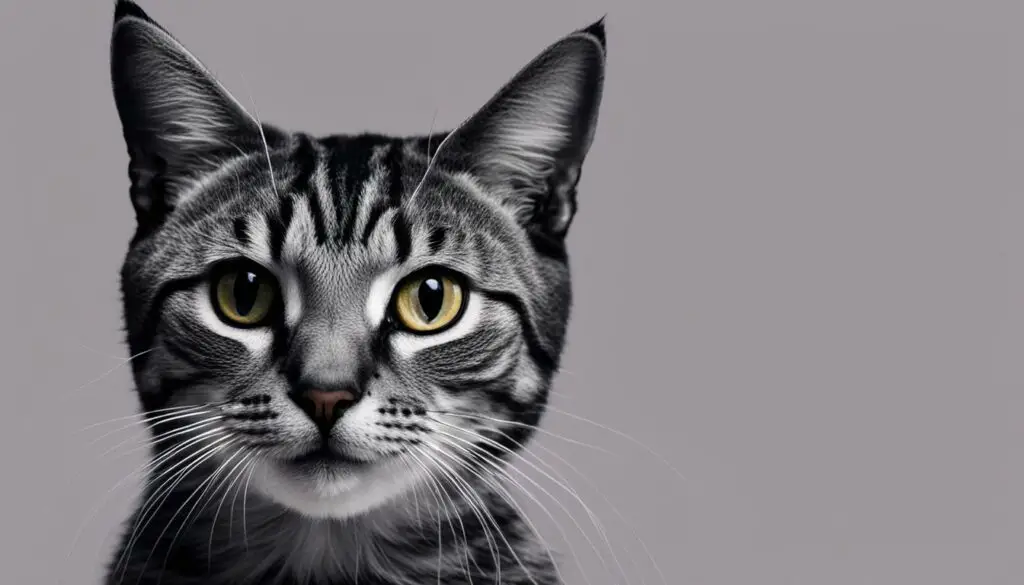
Conclusion
In conclusion, understanding cat grunting is essential for effective communication and maintaining your feline companion’s overall health and comfort. Cat grunting is a natural behavior that cats use to express their emotions, such as fear, discomfort, or excitement.
By recognizing the difference between cat grunting and purring, observing your cat’s body language, and paying attention to their overall behavior, you can better understand their needs and provide appropriate care. If your cat’s grunting is frequent or accompanied by other concerning symptoms, it is crucial to consult a veterinarian for a thorough examination and professional advice.
Creating a calm and comfortable environment, offering cozy beds or hiding spots, and providing interactive toys and playtime are effective ways to provide comfort and reduce your cat’s stress. Additionally, using products like pheromone sprays or diffusers can further aid in creating a soothing atmosphere for your feline friend.
Remember, cat communication goes beyond vocalizations. Understanding their body language, behavior, and interactions with their environment and other cats can enhance your bond with them. By prioritizing their emotional and physical well-being, you can ensure a harmonious and fulfilling relationship with your beloved cat.
FAQ
What is cat grunting?
Cat grunting is a vocalization behavior where a cat produces a low, rumbling noise that resembles a growl.
When do cats grunt?
Cats typically grunt when they feel intense emotions such as fear, discomfort, or pain.
How can I identify cat grunting?
Cat grunting is a low rumbling noise that cats make. It is important to pay attention to your cat’s body language when they’re grunting.
Why do cats grunt?
Cats can grunt for various reasons, including pain or discomfort, aggression, fear, or excitement.
What are the common causes of cat grunting?
Cat grunting can be a sign of stress, fear, discomfort, or disapproval. Cats may also grunt when they are in pain or discomfort.
Which cat breeds are more prone to grunting?
Brachycephalic cats, such as Persian cats and Himalayan cats, are more prone to grunting due to their unique facial structure. Larger cats or overweight cats may also grunt more frequently due to the increased weight and respiratory system requirements.
How should I respond to my cat’s grunting?
When your cat grunts, it is important to observe their behavior and provide comfort and reduce stress. If the grunting is frequent or accompanied by other symptoms, it is best to consult a veterinarian.
What are other cat vocalizations I should know?
Cats make a variety of sounds, including purring, meowing, hissing, yowling, and groaning, each with its own meaning.
When should I consult a veterinarian?
If you notice any sudden changes in your cat’s vocalizations or if the sounds are accompanied by other concerning symptoms, it is best to consult a veterinarian.
How can I comfort a groaning cat?
Creating a calm and comfortable environment, offering cozy beds or hiding spots, and providing interactive toys and playtime can help alleviate your cat’s discomfort. Using products such as pheromone sprays or diffusers can also help reduce stress and anxiety.
Is cat grunting the only form of feline communication?
No, cat communication goes beyond vocalizations. Understanding your cat’s body language, such as their tail, ears, and posture, can provide valuable insights into their emotions and needs.
What is the importance of understanding cat grunting?
Understanding cat grunting can help you address the underlying issue and provide the necessary care and attention to ensure your cat’s well-being and strengthen your bond with them.

